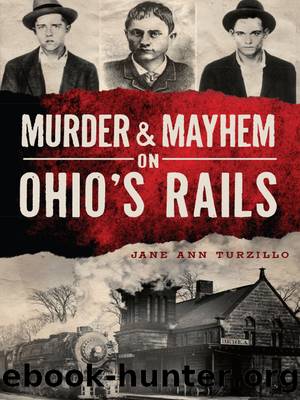Murder & Mayhem on Ohio's Rails by Jane Ann Turzillo

Author:Jane Ann Turzillo
Language: eng
Format: epub
Publisher: Arcadia Publishing Inc.
Published: 2014-09-15T00:00:00+00:00
Outlaws often visited saloons. This one was owned by Frank Chappius Sr. Photo taken in 1906. Williams County Public Library.
The express car was immediately run onto a sidetrack next to the express companyâs office. Wygant boarded the car and surveyed the damage from the impact of six dynamite cartridges. He came to a different conclusion on the condition of the inside of the car. Every window was shattered. A board was missing on the side of the car where the safe stood, and the inside wall had been demolished into kindling.
The big safe had a six-inch circular dent where the dial had been blown off. Bits and pieces of it were scattered all over the car. The robbers left a four-inch stick of dynamite behind. The small safe lay open on the floor in the center of the car.
The press had a hard time nailing down the actual loss because all information had to go through Superintendent Wygant, and he was not forthcoming. In fact, the company ordered all the trainmen to avoid the newspapers.
Various rumors had the loss estimated somewhere between $8,000 and $40,000. One of the rumors that surfaced was that the robbers knew $40,000 worth of jewelry had been put on board the train in Cleveland. Another report put the loss at $800 to $1,000. Finally, Superintendent Wygant released a figure of $150. But another express company authority, Frank Benedict, told reporters the loss would be no more than $50. âAnyone can open the little iron safes, but our new dynamite ones are too much for the men with black masks,â he said. By the âlittle iron safes,â he meant the way safe. The company was proud of its new dynamite-proof safes. They had been installed in all of the companyâs express cars after a large loss during a robbery near Kendallville, Indiana, two years prior.
Theodore F. Swayze, private secretary to United States Express Company president Thomas Platt, talked to the New York Times on July 26, 1895:
The money which was carried off by the robbers was doubtless the contents of the local safe, consisting of small money packages, carried between the different stations on the road. The stationary safe referred to in the dispatch is one of the new kind which have been put into all the money cars of this company recently. The safe weighs three thousand pounds and is fastened to the car by a broad steel band which passes over the top of the safe and is bolted through the floor of the car. It would consume several hoursâ time to release the fastenings and remove the safe from the car. The safes are of an approved construction, which are guaranteed to be dynamite proofâthat is, they cannot be blown open inside of six hours, and no band of robbers can afford to spend so much time over the job.
The safes are provided with removable dials, and these dials are in the possession of the agent at the terminal points. The messenger in charge does not know the combination and could not open the safe without the dial.
Download
This site does not store any files on its server. We only index and link to content provided by other sites. Please contact the content providers to delete copyright contents if any and email us, we'll remove relevant links or contents immediately.
Kathy Andrews Collection by Kathy Andrews(11730)
The remains of the day by Kazuo Ishiguro(8825)
Paper Towns by Green John(5091)
Spare by Prince Harry The Duke of Sussex(5073)
Industrial Automation from Scratch: A hands-on guide to using sensors, actuators, PLCs, HMIs, and SCADA to automate industrial processes by Olushola Akande(4985)
The Body: A Guide for Occupants by Bill Bryson(4974)
Machine Learning at Scale with H2O by Gregory Keys | David Whiting(4183)
Be in a Treehouse by Pete Nelson(3950)
Never by Ken Follett(3794)
Harry Potter and the Goblet Of Fire by J.K. Rowling(3775)
Goodbye Paradise(3728)
Into Thin Air by Jon Krakauer(3313)
The Remains of the Day by Kazuo Ishiguro(3294)
The Cellar by Natasha Preston(3262)
The Genius of Japanese Carpentry by Azby Brown(3226)
Fairy Tale by Stephen King(3220)
120 Days of Sodom by Marquis de Sade(3182)
The Man Who Died Twice by Richard Osman(2997)
Drawing Shortcuts: Developing Quick Drawing Skills Using Today's Technology by Leggitt Jim(2996)
